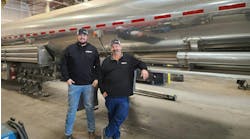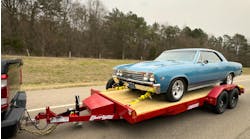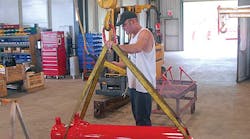A telescopic cylinder is not a structural support designed to prevent side movements and is not intended to provide stability to the dumping vehicle, according to Stephen Vezina, vice president of Mailhot Industries.
In his presentation, “Hydraulic Systems for Vocational Trucks & Trailers 101,” Vezina gave some dos and don’ts:
• Always dump on a firm and even ground.
• Never drive with a raised dump body.
• Stay out of the working area of an operating dump body.
• Load evenly and do not overload.
• Never be under an unsupported body.
“These are all things that, in our day-to-day work in the truck equipment industry, everybody has a responsibility to keep an eye out for,” he said. “If people aren’t careful doing what they do with a dump truck or dump trailer, things happen. When things don’t go right, people have incidents where things have to be put back together and people are at risk of being injured. It’s big equipment, and things can happen if it’s not used properly.”
Vezina said that both types of cylinders—telescopic or single-stage—can be single or double-acting.
A single-acting cylinder is “pressure up, gravity down,” and is used on dump trailers and dump trucks. A double-acting cylinder is “pressure up, pressure down,” and is used where the operator wants to control the angle of the dump body or in horizontal operations where the cylinder is lying flat, or in certain cases where the point of gravity is too high and the weight won’t allow it to come down by itself.
The telescopic cylinder concept is pin-to-pin or with cover, which is where the dump trailer or body is attached to the bottom, and the bottom of the cylinder is attached to the chassis of the truck.
“This is very popular in Canada and certain parts of the US,” Vezina said.
Applications for the single-acting telescopic cylinder design are dump trucks and trailers, and vacuum trucks and trailers.
The double-acting telescopic cylinder design is for specialized boxes with a center of gravity that’s too high.
“Once the cylinder is extended, there’s not enough weight bringing it back down, so the double-acting cylinder is to make sure we’re able to pull or power the dump body back onto the frame of the truck,” he said. “The horizontal application is for environmental trucks. On garbage trucks, you need the power to pull back the cylinder once you’ve ejected whatever. The cylinders will pack garbage as the truck is being used, and once the truck gets to the dump site, the cylinders are fully extended to empty whatever is in the truck.
“It’s also for winter road maintenance. A salt spreader has a higher center of gravity and can’t come down on its weight alone. A double-acting cylinder is very popular in that application to bring the salt spreader back to its original position.”
He said the telescopic cylinder design has evolved over the years:
• Model M, 1970: bore seal; brass piston and gland nut; U-cup seal; nitrided since 1990.
• Model M, 1995: bore seal; steel piston and gland nut; U-cup seal and wiper; nitride.
• Model G3, 2012: rod seal; welded piston and gland nut; U-cup seal and wiper; nitride.
“The cylinder sections are one piece—there is nothing added to them except the seal kit,” he said. “So we’ve really simplified the design of the cylinder from way back, as far as the materials we’re using now and the number of components. The design evolution has brought us something that has fewer parts than it had in the past, and fewer parts means less potential for breaking anything on the cylinder or wearing parts out.”
The information required to select the proper cylinder for your application:
• Box length.
• Box side height.
• Overhang (back hinge location).
• Distance between lower cylinder attach to the hinge.
• Cylinder angle when retracted.
• Hydraulic working pressure.
He said the fully extended dumping angle should be between 50 and 53 degrees.
“When you get way over that, you don’t want to go there,” he said. “It’s too risky. When you’re selecting a cylinder, the stroke of cylinder that you need is based on calculations that will give you the dumping angle. If you do the exercise properly, you won’t end up with something that’s going to give you a 60-degree dumping angle. On the other hand, you don’t want anything too short, like 30 or 40 degrees, because you will have trouble operating the dump truck or dump trailer as it’s intended.”
Vocational Truck Hydraulics
George Artem, sales manager for truck hydraulic products
Parker Hannifin Canada
Artem said a wetline kit is used to connect a vocational truck to a trailer that has a vocational application so the trailer can have power to operate the proper application. Examples: dump trailer; moving floor; oil transfer; low boy; live bottom; and roll off.
It consists of: PTO; combination pump and valve “dump pump” or separate pump and valve; tank; ball valves; relief valves; hose kits; quick couples; filtration; inside-the-cab controls or external controls; connectors; hoses; and hydraulic fluid.
He said Parker Chelsea decided to stay in this market because it manufactures 80% of that product.
How many trailer lines to connect:
• Single line, for dump trailers: one quick coupler to connect a single hose to power the trailer up and letting the trailer back down.
• Two lines, for moving floor, oil transfer, low boy, live bottom, and roll off: one pressure line one and one return line.
• Three lines, for bulk feed: Generally uses a tandem gear pump that has two inlets and two outlets. The trailer has two high-pressure lines and one return line. Gear pumps are normally used but Vane and Bent Axis F2 pumps are excellent alternatives.
• Combo: allows the driver to connect to different types of trailers. This gives the truck greater flexibility in what type of trailer the driver can connect.
Parker has three combination systems to choose from:
• Standard Combo uses a dump pump and is rated up to 2500 psi max the R/V is set to 2440 psi.
• Premium Combo uses a pump and valve system and is rated up to 3000 psi.
• Auto Combo–High Flow uses a pump and valve but does not require any special operation from inside the cab by the driver. Rated up to 3000 psi.
Applications:
• Standard: dump trailer; low boy; and roll off.
• Premium and auto: dump trailer; low boy; roll off; oil transfer; live bottom; frack trailer; and moving floor.
What pumps are used in combo:
• Standard Combo: C102 Series; 2440 psi setting 2500 max; 2½” gear; NPT ports; pump and valve.
• Premium Combo: PGP051 pump; 3000 psi max; 2” gear; O-ring ports; two single-acting valves.
• Auto Combo: high flow; PGP350 easy fit pump; 3000 psi max: 2½” gear; O-ring ports; and one single-acting valve.
Standard Combo advantages:
• Less cost.
• One pressure setting, 2440.
• NPT ports.
• Standard in-cab controls.
• No additional valve needed.
• Works well in 95% for most setups.
Standard Combo disadvantages:
• Some applications may experience difficulty in moving extremely heavy loads.
• Has NPT pump ports that are capable of hydraulic leaks at higher pressures.
Premium Combo advantages:
• In-cab controls monitor two different pressure settings, 3000 and 2250 psi.
• O-ring ports for leak-free hydraulics at higher pressures.
• Easy-to-operate in-cab controls for the driver.
• Able to handle a very wide range of loads.
Premium Combo disadvantages:
• Driver must select the correct pressure hose when quick-coupling the trailer.
• About 15% more expensive over a complete standard combo system.
Auto Combo advantages:
• Automatically monitors pressure settings 3000 and 2250 psi.
• O-ring ports for leak-free hydraulics at higher pressures.
• Standard in-cab controls.
• Faster unloading speeds.
• Easy trailer connections.
Auto Combo disadvantages:
• A little extra cost.
He said that to get the wetline kit you want, determine your application needs based on the type of trailer you need the driver to connect, and how many lines it takes to make the connection.
Go to www.phtruck.com, click on “Wetline Kits” and then click on either “Public–Available to All” or “Private-Password Protected.” Click on the “Flag & Safety Box.” Private users must first log in. Click on “Configurable” or “Component Parts.” Select the application and start selecting components. Note: You will need transmission make and model number. After configuring your kit, click on the summary to view your selections. ♦









